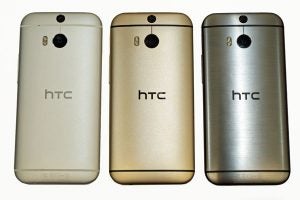Samsung Galaxy S5 vs HTC One M8
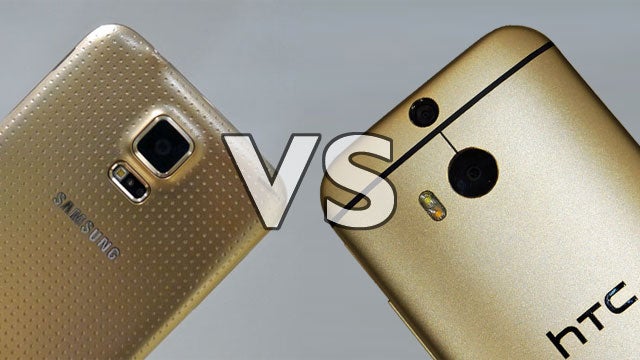
Which is the best Android phone?
Every year, just a few companies battle it out to make the most popular phone of the year. This year two of the top contenders are the Samsung Galaxy S5 and the HTC One M8. But when you cut through the gloss, which is actually the better phone?
We’ve spent time with both, and here’s what we think.
HTC One M8 video preview
![]()
Want to get a closer look at the HTC One M8 and Galaxy S5? Here’s a potted version of our comparison you can watch in just a couple of minutes.
Samsung Galaxy S5 vs HTC One M8 – Price and Deals
Which is the cheaper phone? The HTC One M8 is, but not by a great deal. Mobile network Three’s prices demonstrate the difference well.
Both phones come on the carrier’s £38 a month contract, which gets you 2GB data and 600 minutes. You pay an up-front fee of £69 for the Samsung Galaxy S5, and £49 for the HTC One M8.
£20 is worth saving, but when you pay over £900 for the phones over a two-year contract, it’s best to make sure you have the right phone in your hands rather than make such a saving. Three also offers the best current pre-pay deals for the HTC One M8 in the UK. You’re looking at £459.99, which is actually quite low for a top-end contract-free mobile.
However, its price for the Galaxy S5 isn’t available yet as the phone only goes in sale on 11 April.
Amazon’s prices confirm that the Galaxy S5 is likely to be a bit more expensive than the HTC One M8 across the board, though. It lists the S5 as £559.99, the M8 at £529.99.
Samsung Galaxy S5 vs HTC One M8 – Design
Galaxy S5 – plastic rear, pitted, removable back, water resistance
One M8 – metal rear, unibody, non-removable back, BoomSound speakers
One of the most obvious differences between these two phones is their design. The Samsung Galaxy S5 is primarily a plastic phone, where the HTC One M8 is all about metal.
The Galaxy S5 has a curious looking dimpled back, with ridged silvery sides. It’s all-plastic, though. It is only the Gorilla Glass covering of the display that provides something a bit harder-feeling. The look won’t be for everyone, but the feel is actually not bad. Its rear has a soft touch finish that is more pleasant on the fingers than the glossy plastic of the previous Galaxy S phones.
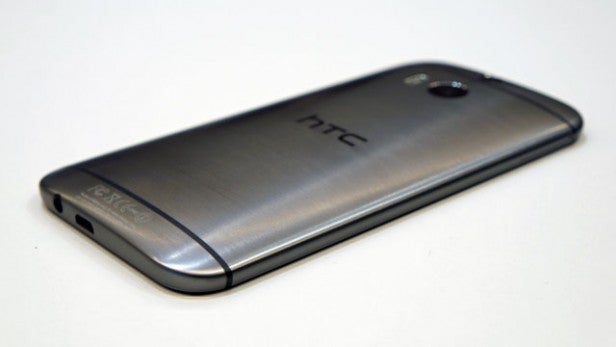
We have to hand this category to the HTC One M8, though. Its simpler, near-all-metal design looks and feels a good deal better, with a cool and hard feel that’s similar to that of the original HTC One.
One difference compared to that phone, though, is the HTC One M8 has dropped any buttons below the screen, instead relying solely on the on-screen controls of Android (aside from the screen unlock button, obviously). In contrast the S5, like the S4 before it, has a trio of buttons. We prefer the route HTC has taken.
The HTC One M8 comes in three different colours, and there are two different metal treatments among them that vary the feel slightly. The ‘Metal Grey’ version has a brushed finish while the silver and gold editions use an anodised-style finish that’s closer to that of the HTC One. All look lovely.
All of the Galaxy S5 models use the same pitted finish, but there are several more colours to choose from. The phone comes in bright gold and blue shades as well as white and black. Samsung has clearly tried, but this is a victory HTC has in the bag.
Here’s a closer look at those colours on offer:
Samsung Galaxy S5 Colours
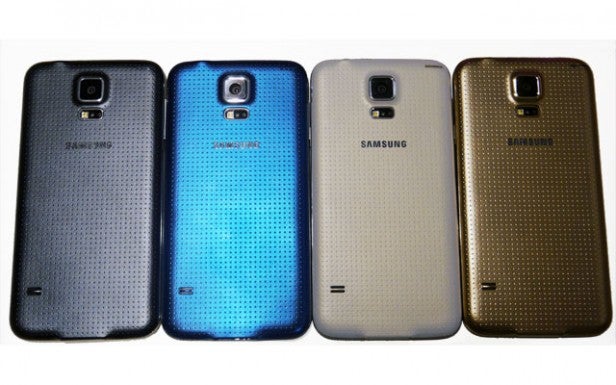
HTC One M8 Colours

Galaxy S5 vs One M8 – Speaker
Galaxy S5 – Single-output speaker on rear
One M8 – dual front BoomSound speakers
The HTC One M8 has much better speakers than the Galaxy S5. It uses front-loaded drivers with deliberately-designed enclosures. HTC calls them BoomSound speakers, and while they’re not going to rival proper speakers – even tiny ones – they are well above average.
Sound is a good deal thicker and more powerful than the competition, including the Galaxy S5.
Samsung’s phone has a depressingly ordinary speaker. Like the S4’s, it sits on the back, firing away from you rather than towards you. Although top volume is decent, the sound is quite thin and tinny-sounding – getting quite harsh at top volume. The HTC speakers are much, much better.
As well as being great for casually listening to music, the HTC speakers are also great for playing games and watching videos.
Galaxy S5 vs One M8 – CPU and RAM
Galaxy S5 – Snapdragon 801 at 2.5GHz, 2GB RAM
One M8 – Snapdragon 801 at 2.3GHz, 2GB RAM
The Galaxy S5 and One M8 use the same processor type – the Snapdragon 801. However, the Galaxy S5 uses a slightly higher-clocked version. Where the HTC One M8 has a 2.3GHz chipset, the Galaxy S5’s is 2.5GHz. There is a 2.5GHz version of the HTC phone, but we don’t get it in the UK.
There’s hardly any noticeable performance benefit in day-to-day use, though. You’ll get a few more points on benchmarks like Geekbench 3, but in apps and games the phones perform at the same level. They each have 2GB of RAM too, which is the norm for top-end phones – although some like the Xperia Z2 have 3GB of RAM.
There’s nothing on Google Play that these phones can’t handle. The only concern at this point is that Android is likely to ‘go 64-bit’ reasonably soon. It’s currently a 32-bit platform, but Qualcomm has just announced the Snapdragon 808 and 810, which are 64-bit chipsets that are highly likely to power some of late 2014’s top Android devices.
The Nexus 6 is one mobile phone that might make the leap this year. And any apps that really make use of the 64-bit power may not do everything on a 32-bit phone. However, we’re a way off seeing apps that only work with 64-bit phones.
Samsung Galaxy S5 vs HTC One M8 – Storage
Galaxy S5 – 16GB, microSD slot
One M8 – 16GB, microSD slot
Although higher-capacity versions of both these phones are planned for other markets, it’s likely that most UK stores will only stock the 16GB versions of both the Galaxy S5 and HTC One M8.
Why? Because they have microSD memory card slots. With the HTC One M8 you’ll find a pop-out tray on one side of the phone. In the Galaxy S5 it’s found under the removable rear. For the HTC, it’s a major addition over its predecessor, which many chose to avoid due to the lack of a microSD slot.
Samsung Galaxy S5 vs HTC One M8 – Screen
Galaxy S5 – 5.1-inch Super AMOLED, 1080p resolution
One M8 – 5-inch SLCD, 1080p resolution
The HTC One M8 has the same size screen as last year’s Samsung Galaxy S4, once again reflecting that HTC’s top phones don’t tend to try to offer the biggest screens in their class.
However, the Samsung Galaxy S5 display is only a tiny bit bigger at 5.1 inches. In pure size terms the difference isn’t worth worrying about too much.
They use rather different core technologies, though. The Galaxy S5 has a Super AMOLED display; the basic type used by previous Galaxy S phones.
The HTC One M8 has an SLCD screen that’s much closer in tech and style to the IPS display seen in phones like the iPhone 5S. These technologies excel in different fields.
Super AMOLED screens are great at reproducing contrast and a deep black level. Even in dark rooms, the Galaxy S5’s blacks will look black. In the same conditions, the HTC One M8’s blacks will likely be slightly grey-ish.
However, LCDs on phones tend to offer higher top brightness (better for outdoors) and more natural-looking colours. Samsung has really worked on its colour calibration this time around, though. We’ll make a more in-depth analysis of these screens in our upcoming full reviews but for now they’re hard to pick apart as they’re both top performers.
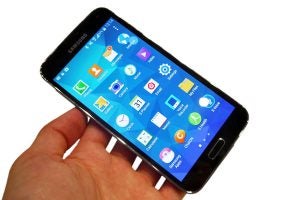
Samsung Galaxy S5 vs HTC One M8 – Software
Galaxy S5 – Android 4.4 with TouchWiz
One M8 – Android 4.4 with HTC Sense 6
Both phones use the latest version of Android: 4.4 KitKat. However, as their interfaces are completely different, they don’t feel all that similar in use.
If you have experience of last year’s top models from HTC and Samsung, these interfaces will seem pretty familiar, though. The new models largely continue the style of their predecessors.
Samsung has pared-back the style of TouchWiz a little bit and touched up the look to make it appear a little simpler, but it’s still a feature-packed system. HTC’s Sense 6 offers fewer add-ons, but most people will find it a bit easier to use.
It’s also a little easier on the eye. HTC’s less (or at least not too much) is more approach really works in the M8, and this time you have control over the font of the system too. One of the options is Helvetica, which brings the phone a classy look.
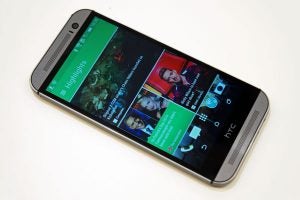
Samsung Galaxy S5 vs HTC One M8 – Camera
Galaxy S5 – 16-megapixel ISOCELL sensor with with LED flash, Phase detection Auto-Focus
One M8 – Duo camera system with 4-megapixel UltraPixel main sensor, dual LED flash
Both of these phone cameras are very interesting, and aren’t mere spec upgrades – the Galaxy S5 bumps up the megapixel count, but it’s not all the phone does. It also has a new kind of sensor and a new kind of focusing system.
It’s the first phone to use an ISOCELL sensor, which Samsung positions as a successor to the BSI sensors used in most phones. It reduces crosstalk between sensor pixels by putting a barrier between them. The result is better colour fidelity and richer-looking images when compared to a BSI sensor of the same size and spec.
The HTC One M8’s UltraPixel main sensor is trying to attack the same problem – the deficiencies of tiny mobile phone cameras – but from a different angle. Its sensor reduces resolution in order to fit in larger sensor pixels. Detail is reduced, but other photographic aspects get an increase in fidelity compared to other mobile cameras.
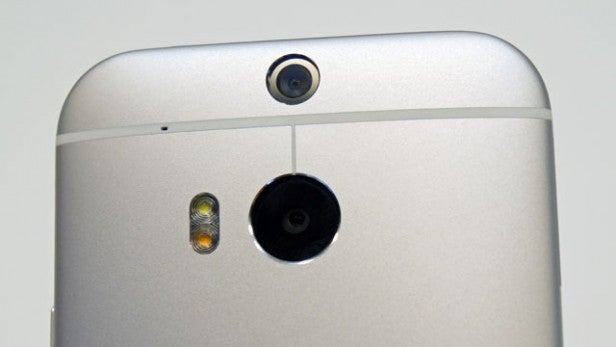
This is just the beginning of the interesting camera elements. The Galaxy S5 also has a phase detection module to give focusing times of just 0.3 seconds in daylight, while the HTC One M8 has a second rear sensor that records depth information to let you blur out of the background or foreground reliably without much effort or post-processing. However, it doesn’t work perfectly.
Which is better? In daylight, the Galaxy S5 will produce vastly more detailed photos. However, at night, it’s likely the HTC One M8 will take more accurate photos due to its theoretical better low-light performance. While the Galaxy S5’s sensor has become bigger to fit in the extra 3MP resolution of the 16-megapixel sensor, the actual sensor pixels are still 1.12 microns across – the HTC One M8’s are two microns a piece, so they pick up more light.
Galaxy S5 vs One M8 – Battery Life
![]() Galaxy S5 – 2,800mAh
Galaxy S5 – 2,800mAh
One M8 – 2,600mAh
The Galaxy S5 has less than 10 per cent extra battery over the HTC One M8, but we noticed a significant improvement in battery life over the HTC phone in use.
We got more than an hour’s worth of extra video playback with the Galaxy S5, and you’re much more likely to be able to get the Galaxy S5 to last for a full two days. Both of these phones last longer than their predecessors the Galaxy S4 and HTC One, though.
Qualcomm put plenty of battery efficiency measures into the 800 and 801 chipsets to make them more efficient than the older models, and it is partly what enables the power-saving modes seen in both these phones. They have a normal power saving mode, which clips a few features to make them less battery intensive, and an extreme power mode. This has its own interface that only gives you access to a few apps.
The Samsung one also makes the screen black and white, as that reduces the power consumption of the OLED screen.
Which is the better phone?
In some respects, we tend to prefer the HTC One M8. Its metal body just looks and feels so much better than the Galaxy S5’s plastic shell. However, in daylight the Samsung’s camera will produce much more detailed shots and its water-resistant frame is also a boon. We’ll be back with more impressions once we’d had more time to play with these phones.
Next, read our HTC One M8 vs original HTC One comparison


